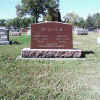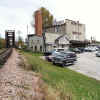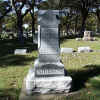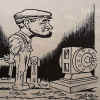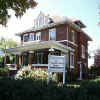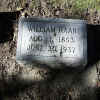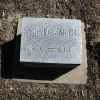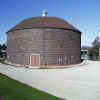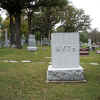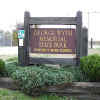| On January 20, 1872, Cornelius Neil McHugh was born in the southern Wisconsin town of Gratiot. At sixteen, he moved to Iowa and found a job cutting broom corn in the fields near Cedar Rapids. Soon he was placed in the factory as an apprentice, where he learned the broom trade. In 1905 McHugh came to Cedar Falls to start his own broom factory. Two years later he formed the Cedar Falls Broom Company in a building on the Cedar River that had formerly been used as a wooden pump factory and an oatmeal mill. [1] McHugh also produced pickles in the factory he operated for almost forty years. Today, the restored Broom Company building serves as the Olde Broom Factory Restaurant, one of the more unique restaurants in the area. |
|
| In 1931 McHugh was persuaded by friends to run for the office of councilman-at-large,
a position that he easily won. After serving two terms on the council, he was elected
mayor of Cedar Falls in 1935. His administration oversaw many improvements, including
annexation of Cedar Heights (1935) and the building of a hydro-electric plant in 1941. [2]
This plant made it possible to harness water power from the river. McHugh also worked to
improve the grounds of Greenwood Cemetery, created a modern police room and jail,
supported public parks in Cedar Falls, and was instrumental in the building of a swimming
pool. [3] His success in both business and politics made him a popular man in Cedar Falls.
Mayor McHugh died at Satori Hospital of a heart attack on November 1, 1944. He still held
the office of mayor at the time of his death. |
Footnotes 1. Margaret McHugh Chehock, Mayor C.N. McHugh: His Love Affair With Cedar
Falls 2. Chehock, Mayor C.N. McHugh, 19. 3. Chehock, Mayor C.N. McHugh, 20. Bibliography Chehock, Margaret McHugh. Mayor C. N. McHugh: His Love Affair With Cedar Falls.
Cedar "Mayor McHugh Dead at Age 72." Waterloo Courier, Nov. 2, 1944, A:
3. |
Footnotes
2. Glenda Riley, Cities on the Cedar (Parkersburg: Mid Prarie Books, 1988), 37. 3. Hake, 45. 4. Hake, 45. Bibliography
Hake, Herb. 101 Stories of Cedar Falls. Cedar Falls: The Record, 1977. Riley, Glenda. Cities on the Cedar. Parkersburg: Mid Prarie Books, 1988.
|
| John Raab was born on May 10, 1829, in Austria. His family had been distinguished potters in Silesia for over five generations. As he grew up, he served as an apprentice for several master potters until 1851. [1] Raab married Johanna Greger that year, and they had a son, William, on August 1, 1854. On the advice of a younger son who had already immigrated, the Raabs came to America in 1874. They arrived in Philadelphia, but moved to Cedar Falls on the advice of a friend the following year. Here John Raab bought a piece of property at 312 Water St. and opened Raab's Stoneware and Terra Cotta Works. [2] The clay that Raab found in the area proved below his standards, so he imported clay from other states to produce his drain tiles, sewer pipe, stoneware jars, and crocks. In the 1880's, double and triple flue chimneys also became part of the business. Later in his career, Raab concentrated on his talents as an artist, and began to create vases, figurines, and other art work. [3] John Raab died on November 4, 1908, at 80. |
|
Footnotes 1. Herb Hake, 101 Stories of Cedar Falls (Cedar Falls: The Record, 1977), 30. 2. Mary Logan Sweet, Stoneware in Cedar Falls, (Cedar Falls: Cedar Falls
Historical Society, Bibliography Hake, Herb. 101 Stories of Cedar Falls. Cedar Falls: The Record, 1977. Sweet, Mary Logan. Stoneware in Cedar Falls. Cedar Falls: Cedar Falls Historical
Society,
|
| William Raab was born to John and Johanna Raab on August 1, 1854. Following the family tradition, he was apprenticed as a potter. After his eighteenth birthday, he came to America with friends, and encouraged his family to follow. He worked with his father in the family pottery shop and in 1881, took out a patent for a double and triple flue chimney. [1] These chimneys became an important part of the Raab business, now known as J. Raab and Son. Later that decade, John Raab bought his son's share of the company, and William moved to Waterloo where he continued his pottery. [2] He married Anna Benser in 1899, and they had six children. William is also remembered from having created the Rebecca vase, a clay piece that measured between 3/4 and 5/8 inches tall, and could hold between 3 to 7 seven drops of water. What made these vases unique was that the clay was taken from the Holy Land, and each had the Lord's Prayer incised on the side. [3] William gave these to prominent people in Cedar Falls and throughout the world, including William Jennings Bryan, King George V of England, and Mrs. Woodrow Wilson. Raab died at age 82 in July 1937. |
|
Footnotes 1. Mary Logan Sweet, Stoneware in Cedar Falls, (Cedar Falls: Cedar Falls
Historical Society, 2. Sweet, 14. Bibliography Hake, Herb. 101 Stories of Cedar Falls. Cedar Falls: The Record, 1977. Sweet, Mary Logan. Stoneware in Cedar Falls. Cedar Falls: Cedar Falls Historical
Society,
|
| Hugh Smith was born in Colfax, Iowa, on February 28, 1871. He spent most of his life on a farm south of Cedar Falls. In 1910, Smith began to manage a wooden ice house that was owned by the Frisby Lumber Company. [1] In February 1917, he purchased the ice house and founded the Cedar Falls Ice and Fuel Company. On October 22, 1921, Smith received word that the wooden ice house had caught on fire. Sadly, it burned to the ground in less than an hour. [2] With the help of the Cedar Falls community and an out of town engineer, Smith turned his great loss into an opportunity to build a better ice house. He built a circular building with hollow clay walls that was capable of holding between 6,000 and 8,000 tons of natural ice cut from the Cedar River. [3] Smith's new building functioned as the ice house until 1934, when he was forced out of business, due to debt and the popularity of mechanically frozen ice. Today, the Ice House is a museum open to the public, listed on the National Register of Historic Places. Hugh Smith was working at a filling station in Cedar Falls on September 12, 1944, when it was robbed. He was hit over the head during the robbery, and his death on February 5, 1945 was a result of complications from this injury. [4] |
|
Footnotes 1. "Hugh Smith, Attack Victim, Dies at D. Moines," Waterloo Courier, 6 February 1945, sec. A:3. 2. Herb Hake, 101 Stories of Cedar Falls (Cedar Falls: The Record, 1970), 101. 3. Hake, 101. 4. "Hugh Smith," Waterloo Courier, 6
February 1945, sec. A:3. Bibliography Hake, Herb. 101 Stories of Cedar Falls. Cedar Falls: The Record, 1977. "Hugh Smith, 73, Attack Victim, Dies at D. Moines." Waterloo Courier, Feb. 6, 1945, A: 3. The Ice House Museum. Cedar Falls Historical Society. Cedar Falls, 1980.
|
| J. George Wyth was born in Cedar Falls on December 17, 1869. He was forced
to quit school in the seventh grade and became a grocery store delivery boy. Later, he and
a partner established a shoe store. After the invention of the rotary pump by Jens
Nielsen, Wyth teamed with Nielsen and two other partners to found the Viking Pump Company
in 1911. Wyth became the first president of the company. In 1944, he retired from the
Viking Pump Company as both president and general manger. [1] Wyth also worked hard to
establish the Cedar Falls Park System and was elected as a charter member of the first
Park Board in 1919. [2] He devoted huge amounts of time and energy to the establishment
and development of the city's first two parks, Overman and College Hill. Interestingly
enough, Wyth himself was not a man who spent much time outdoors. The work that he did to
establish recreation areas was for others, not himself. [3] His unselfish nature led the
Iowa State Conservation Commission to vote unanimously to change the name of the Josh
Higgins Parkway to George Wyth Memorial Park in the summer of 1956. (Josh Higgins had been
a fictitious character on a radio program.) [4] Today, his house is open to the public as
part of the Cedar Falls Historical Society. Wyth died in Cedar Falls on May 19, 1955. |
|
Footnotes 1. Cedar Falls Historical Society Archives: Series III: Box 8: Folder 5: Gus
Campbell, 2. "George Wyth: The Man Who Gave us a Park and Much More" Waterloo
Courier, 3. "George Wyth:" Waterloo Courier, 24 August 1984, sec. CF:2. 4. "George Wyth:" Waterloo Courier, 24 August
1984, sec. CF:
2. Bibliography George Wyth House. Cedar Falls Historical Society. [Leaflet]. Historical Tour of Blackhawk County Iowa: Celebrating Iowa's Sesquicentennial 1846-1996. Cedar Falls Historical Society.CFHSA: Series III: Box 8: Folder 5: Gus Campbell, "George Wyth: The Man Who Gave us a Park and Much More."
Waterloo
Courier, 24 August |
